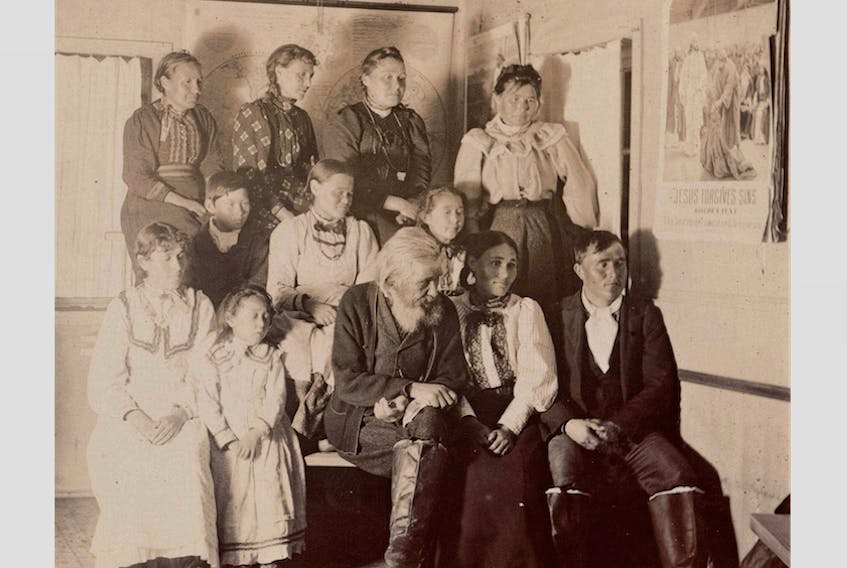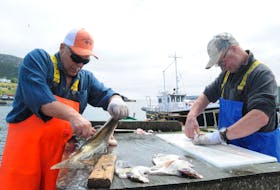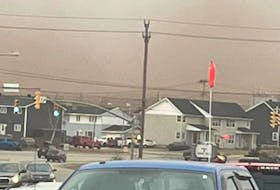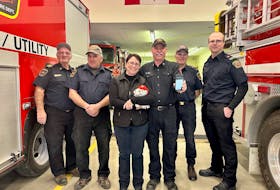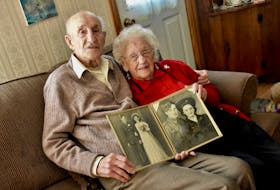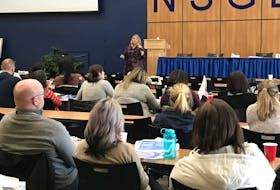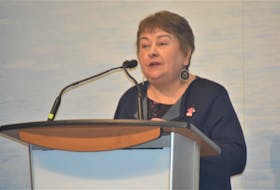BY FLOYD SPRACKLIN
SPECIAL TO THE LABRADORIAN
Editor’s note: This story originally ran in the June 25, 2018 edition of the Labradorian.
If anything is to be learned from researching a family member or any other person, it is this — every connected individual holds a piece to the puzzle. It is a virtual treasure hunt to find all those pieces and fit them together into a picture that all can hold near and dear.

Learning more about the life of Thomas Flowers has been much like what George Gregoire of Natuashish suggests in his book, “Walk With My Shadow”. We can choose to walk with our own shadow, never feeling alone, or we can walk in someone else’s footsteps knowing this well-worn path is safe.
Many of our veterans live and die with very little collected and/or written about them in one place. Thomas Flowers of Nain, whose grandfather arrived in Rigolet from England in the 1800s, is included in this group of silent and unsung heroes.
Military records for Private Thomas Flowers have survived though only place names and dates have been identified for where and when he was on active duty. No specific details are provided for any of his enemy engagements. What we do know from his military attestation documents obtained from The Rooms Provincial Archives & Museum, is that on Oct. 24, 1917 in St. John’s, Thomas enlisted with the first Newfoundland Regiment, C of E Corps, Regimental Number 4019 and was posted to G Company. At this time he declared his birthdate to be June 1, 1899 – not his actual birthdate — and his next of kin, Frances Flowers, his mother in Hopedale. Like so many before and since, he said what he had to say to enlist. All 5 foot 6 inches and 138 pounds of Private Flowers was ready to serve King and Country.
Before leaving St. John’s, Private Flowers was treated for mumps at the Military Infectious Hospital Dec. 22, 1917. Four weeks later he embarked on the SS Florizel for Halifax Jan. 29, 1918, and from there on Feb. 7, 1918, his 18th birthday, to Folkestone, located on the English Channel in England on an unnamed troop vessel.
In July of 1918 and before commencing active field duties, Thomas authorized quarterly $2.50 deductions to the Prisoners of War Fund. This amount would each month be taken from his Private Soldier’s Rate of $1.10 per diem for a period of one year, a total of $10 during the time in which he would have collected a total of $400 in soldiers’ pay.
From July 8-Nov. 3 of 1918, Private Flowers was engaged in military operations on the Western Front in Boulogne and Rouen in northern France and then in Flanders, Belgium. During those four months, Private Flowers and the First Newfoundland Regiment saw enough action to last a lifetime. It was hand-to-hand combat in muddy, churned up battlefields. The men, many of them quite young, took heavy casualties under constant German artillery field gun bombardment. At one point and under fire the Newfoundlanders crossed the River Scheldt by raft. No mention is made of Private Flowers’s specific assignments though the story back home in Labrador was and continues to be about his marksmanship skills and his being a First World War sniper.

In August of 1918, Private Flowers was admitted to a French hospital with bronchopneumonia. In between on Oct. 12, 1918, he was treated for scabies at Rest Camp Cherbourg. By early November Thomas had contracted dysentery and then diphtheria and as a result had to be evacuated back to England. By the middle of November he was released from Bermondsey Hospital in London and declared fit to return to active duty at Winchester by which time the Armistice of Nov. 11, 1918 had already ended The Great War.
Sometime in 1918 Private Flowers had authorized a daily deduction of 60 cents from his Private Soldier’s rate to be sent back home to his mother. In February of 1919, this transaction was cancelled due to the end of his tenure with the Newfoundland Regiment. On April 9, 1919 he was discharged, and April 10, 1919, he was declared physically unfit for further war service.
Thomas departed England in early July of 1919 for Halifax and was officially demobilized and discharged with no disability from the military physician on July 14 of the same year. At that time he was cleared by the Civil Re-establishment Committee to return to his former occupation as a fisherman. His repatriation cites 264 days of service with colours and a total of 365 days for reserve. However, he did have one minor matter to attend to. He was issued civilian clothes which came with an amount owing of $60.
Private Flowers arrived at his Labrador home in the wake of the 1918-19 Spanish flu epidemic that had killed 20-40 million people worldwide. This pandemic had first arrived aboard the SS Sagona docked at Cartwright with four infected crew. From there it spread like wildfire throughout Labrador and killed 10 per cent of the northern population. In the small Inuit community of Okak alone, 78 per cent of its 263 residents had succumbed to the Spanish flu. To complicate matters, Thomas himself was recovering from a bout of diphtheria that he had picked up while serving in Belgium.
After nearly two years of service to his country, Thomas had returned home, figuratively and literally a grown man. He had added a full inch to his stature since he was still a growing boy. Regardless of his self-reporting his age to be 19, he was in actual fact only 17 when he had enlisted.
Happily, Labrador was where he would spend the second half of his life, getting married, having and raising children, fishing for a living, spending time on The Land, and helping his community whenever and wherever possible. Sadly, very little of what would happen in his remaining 22 years would be documented in as much detail as his last two years overseas.
On Feb.20, 1920, Thomas married Sabina Aggek in Hopedale at the same time as his sister, Margaret, married Frederick Frieda in a double-wedding ceremony. The next month on March 23, Thomas received the British War Medal in his Hopedale mail. Two months later Thomas received his Victory Medal in the same manner and quickly acknowledged receipt of both by return mail. The Victory medal was awarded to all ranks of the fighting forces who actually served in a theatre of war between Aug.5, 1914-Nov. 11, 1918.
Shortly thereafter, he also received the British War Medal, awarded to all ranks of Canadian and Newfoundland overseas military forces who had also served in a theatre of war, both with no official ceremony attached. Thomas would keep both medals hidden in his home until near his death. Around 1924, Thomas and Sabina moved to Nain to set up their family home far away from his battlefield memories.
The July 8, 2018 Hopedale mail brought Thomas three cheques totaling $210 from the military. This was officially notated as his balance of War Service Gratuity.

Thomas’s father, William, and Aunt Mary Ellen had moved north from their birthplace of Rigolet somewhere most likely around the 1860s, and shortly thereafter in 1869 William had married and had their first child in the same year. The famed Flowers salmon river and Flowers Bay, both located just south of Sango Bay and Davis Inlet, have inherited their names from them.
By 1930, Thomas had lost his four brothers and sisters. What we do know is that Thomas and Sabina had 10 children, most of whom died very young. Eighty-nine year old Gus Flowers of Nain is the only living child of Thomas and Sabina Flowers, but due to ill health was unavailable for an interview. Great-granddaughter Emma Rose Murphy of Nain says, “Many of the people who may have known anything specific about Thomas are all gone now. They didn’t know much because he never wanted to talk about it [The Great War].”
War is horrendous and unforgiving, and if you’re lucky, you live to return home and to family. But then what? Memories and flashbacks of dying war buddies continually haunted Thomas. Sophie (Twiggy) Pamak of Hopedale was adopted by her grandparents, Dick and Nancy Pamak, whose father was Thomas Flowers.
Sophie recalls the few words often repeated over the years, that when Thomas came back after the war, “He was a changed man”. Thomas was one of those who kept quiet about what he experienced during the First World War, so much so that those close to him eventually gave up asking.
Thomas was a great provider for his family and his community. He grew up loving The Land and is remembered as a remarkable marksman. His sharpshooting skills and his desire to serve his country of England are what first motivated him to ship overseas to do his part. Emma Rose Murphy, Thomas’s great-granddaughter, says only a few things have been passed down through the years.
“He loved hunting and fishing, providing for the people, and he was an expert shooter,” she said.
FW Peacock in his “Reflections From a Snowhouse” at The Labrador Institute acknowledged all the Flowers of Flowers Bay for their carving and sharpshooting talents. He specifically named Chesley Flowers, George Flowers [son, Gilbert Flowers, a descendant of Thomas’s half-brother, David, a remarkable carver living in Hopedale today] and Ross Flowers of Hopedale as skilled carvers. Emma-Rose adds that another noted living Nain carver is Thomas’s grandson, Gilbert Hay.
Private Thomas Flowers served in France and Belgium and died 23 years after his discharge from the Royal Newfoundland Regiment. Reverend Peacock states that the flu epidemic of 1942 was unwittingly picked up in Hopedale and transported back home by Nain residents trying to procure food and molasses to bolster their depleted stores back home. Thomas’s death came 10 days after the Saturday before Easter Sunday or April 14.
Reverend Peacock says in his book, “On Good Friday our patients began dying….by the time the epidemic ended a month later twenty-two people had died. Tom was …. a strong good man. He had been my right hand during the last three weeks of the epidemic. A modest, quiet man….he moved about the village, throughout the sickness, appearing wherever he was wanted, doing whatever was needed without fuss or comment, stretching out his hands in merciful comfort.” Tom not only tended to the sick and dying. He also helped the Moravian ministers bury the dead.
Rev. FW Peacock and Brother P Hettasch write in “The Periodical Accounts of the Work of the Moravian Missions, June, 1944” obtained from The Labrador Institute, that the evening before Easter Sunday Thomas conducted his first and only service, a prayer meeting at the Moravian Church. Where normally 300 congregation members would gather for Easter celebrations, only 21 showed up that evening.
Reverend Peacock goes on to say that Thomas’s 16-year-old daughter, Mikkijok, had died earlier in the epidemic.
“This attractive young woman knew she was dying and begged me to sit with her. Weary and overwhelmed by the immensity of the task I was facing, I could not deny her request and sat with her for several hours, holding her hand as her life slipped away.”
Rosina Brown, great-granddaughter of Thomas Flowers, said her great-grandfather always told stories and repeated nursery rhymes. However, he didn’t like telling and retelling the ones about his First World War deployment. He grew so tired of people asking him to talk about the war that he organized a one-time community meeting where he could tell his story one last time, but this time to a larger setting.
Rosina says an unknown man came to her mother Miriam’s home in the early 1970s and borrowed with a promise to return Thomas’s two medals and uniform.
“He even asked for anything she might have on hand in her care that was left over from the war.” Regrettably, neither has since been seen. His wife, Sabina was so upset because, besides her memories, these had been the only tangible things left to remind her of her husband.
Rosina Brown goes on to say that sometime after Thomas’s death a Government Man came to Sabina’s house to deliver a cheque of over $200 for an unknown reason. Sabina took the cheque and tore it to shreds and cried, “This is not going to fix Tom!”
Great-grandfather Thomas’s survival from his war experiences were somewhat of a miracle. Thomas made many new friends while fighting alongside them as an 18-year-old in 1918. Military leaders couldn’t believe he had made it out alive, but he did what he had to in order to survive.
“My friend had just been shot and killed, and the enemy was moving in on us. I crawled underneath his body and pretended to be dead until the enemy was gone!” These are reportedly Thomas’s words about one of his many close calls with death and recorded in family memories.
The stories Thomas told about growing up and leaving Labrador to serve overseas and returning to resume an active and normal life have for the most part been lost in oral tradition. Hopefully some other family members will read this article and start their own process of finding out even more for themselves, their community, for Labrador, for veterans, and for everyone to know that he did make a difference. And oh yes, the family search for his medals and uniform is still on.
In 2017, coincidentally or by design, 100 years from the year of Thomas’s enlistment, Emma Rose honoured her great-uncle’s memory with a simple photograph on her Facebook page.
SilakKijak IssoKangitumut
Rest in Peace

